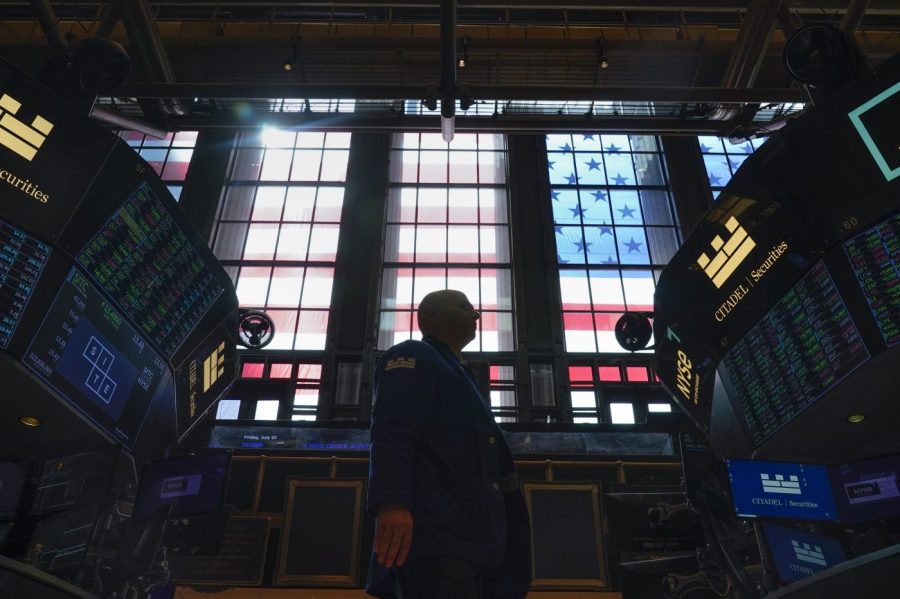The September jobs report was another upside surprise for the postpandemic economy, and central bankers are projecting confidence about overall conditions, but business leaders are seeing some clouds gathering in the distance.
Business sentiment surveys released this week are showing that leaders feel uncertain about where they are in the business cycle, with implications for capital spending and investment, and some are expecting a downturn on the midterm time horizon.
A new survey of executive sentiment on the economy from PwC has found that 61 percent of business leaders expect a recession within six months, an increase from 49 percent in June. The survey found that 68 percent of executives cited “both an uncertain geopolitical and an uncertain macroeconomic environment.”
The small business optimism index released Tuesday by the National Federation of Independent Business found that uncertainty among Main Street businesses had reached an all-time high, with the index climbing to 103 in September from 92 in August.
Overall optimism increased to 91.5 from 91.2 in August, which is within the range of a lower plateau in optimism reached in 2022.
In an interview with The Hill, PwC national tax office co-leader Rohit Kumar described the increase in expectations of a downturn among executives as “surprising” and “much higher than expected.”
“There’s a real sense from business leaders that the macroeconomic environment had degraded,” Kumar said.
Policy issues in the presidential race may be playing into the uneasy feelings from business leaders. Economic proposals from both the Trump and Harris campaigns have come out in bursts and have drawn criticism from those in the policy establishment.
Executives have “severe angst” about Vice President Harris’s proposal to increase the corporate tax rate to 28 percent from 21 percent, Kumar said. Increasing corporate taxes would have a range of financial implications, including likely effects on company earnings, capital expenditures and compensation levels.
The main concerns about former President Trump’s policies focus on the “proposed scale of tariffs,” which are now as high as 20 percent and have taken particular aim at China.
Trump had been proposing a 10-percent general tariff on imported goods, with up to a 60-percent tariff on Chinese goods, but raised it to 20 percent during the presidential debate in September.
He has also talked about reciprocal tariffs on automobiles, recalling the trade dispute with China he navigated during his presidency.
“If somebody charges us a hundred, we charge them a hundred,” Trump said in an interview with Larry Kudlow on Fox Business last week. “If China charges us on a car 100 percent, we charge them on a car 100 percent. It’s very simple.”
The Tax Foundation’s senior economist Erica York in a recent analysis drew some distinctions between Trump’s exuberant views on protectionist tariffs and those of former President William McKinley, whom Trump has cited as a policy exemplar on trade.
“While Trump proclaims, ‘Trade wars are good and easy to win,’ some of McKinley’s final words on tariffs were less enthusiastic. McKinley declared in a 1901 speech, ‘Isolation is no longer possible or desirable. … The period of exclusiveness is past. The expansion of our trade and commerce is the pressing problem. Commercial trade wars are unprofitable,’” she wrote earlier this month.
While business leaders are growing concerned about the state of the economy and the proposals about how to handle it, U.S. economic data continues to shine.
In September, the economy added 254,000 jobs, and the unemployment rate dropped by a tenth of a percentage point to 4.1 percent from 4.2 percent. That’s after unemployment popped over the summer to 4.3 percent.
U.S. gross domestic product also came in strong at 3 percent in the final estimate for the second quarter. U.S. trade deficits fell back by 10.8 percent as exports increased by 2 percent in August.
“The S&P 500 posted its largest decline in just over a month yesterday, but it’s still experiencing its strongest [year-to-date] performance of the 21st century so far, having risen by 19.4 percent since the start of the year,” Deutsche Bank’s research strategist Jim Reid wrote in a Tuesday commentary.
President Biden recently criticized Sen. Marco Rubio (R-Fla.) for referring to the strong September jobs report as “fake.”
“The job numbers are what the job numbers are,” he said. “They’re real. They’re sincere. They’re where we are.”
Consensus about the timing of recessions among economists proved to be erroneous, as the relationship among well-established economic variables faltered. Federal Reserve economists predicted a recession for 2023 before pulling back on that prediction later in the year.
The macroeconomic effects of large amounts of government rescue stimulus, taking the form of various commercial loans and tax credit programs, almost certainly have something to do with the different mismatches and will likely be studied by economists and policymakers for years to come.
But as inflation has fallen back to the Fed’s target of a 2-percent annual increase and the central bank has begun to reduce interest rates from historically elevated levels, the postpandemic economic period is likely coming to an end.
Concerns about consumer spending in the new interest rate environment are persisting among economists.
“Recent revisions to personal income and spending data put the U.S. consumer on firmer footing and suggest greater resilience in the household sector, but we do not subscribe to the argument that Fed rate cuts will suddenly inject new life into consumer spending,” Wells Fargo economist Tim Quinlan and others wrote in a Tuesday commentary.
“Consumers went the full 12 rounds with the Fed in this cycle and never suffered a knock-down. But if rate hikes were insufficient to slow consumer spending, why should lower rates be the magic elixir to make it grow?” they asked.

